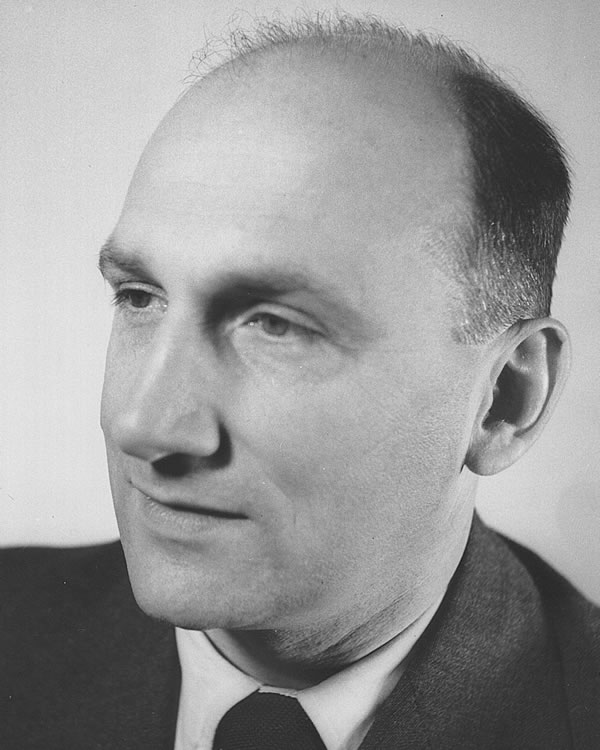Vladimir Prelog (1906–1998)
Professor of organic chemistry at ETH Zurich

Vladimir Prelog was born in Sarajevo on 23 July 1906. He studied at the Czech Technical University in Prague from 1924 to 1929, where he went on to teach until 1935. From 1935 to 1941 he worked at the Technical Faculty in Zagreb, where he became an associate professor in 1940.
Escape to Switzerland
After the German invasion, he left occupied Yugoslavia in 1941 and accepted a position at ETH Zurich's Laboratory of Organic Chemistry under Nobel Prize winner Leopold Ruzicka. Initially registered as auditor, he became a senior lecturer there in 1942, an adjunct professor in 1945, an associate professor in 1947 and a full professor of organic chemistry in 1950.
Succession of Ruzicka
In 1957 he succeeded Leopold Ruzicka as head of the Laboratory of Organic Chemistry. A position he held until 1965. At which point he introduced a job sharing scheme for the position of head of institute.
In his scientific work, Prelog primarily focused on the structural clarification and synthesis of natural substances. He especially devoted his research to nitrogenous, vegetal substances (alkaloids), antibiotics and ferrous compounds from microorganisms.
Stereochemical problems
He spent years studying stereochemical problems. He was particularly interested in the precise spatial structure and behaviour of organic compounds. He especially received recognition in this field for his research on "middle rings", namely ring compounds that contain 8 to 14 carbon atoms. In acyloin synthesis, Prelog found a method for producing such compounds, which had barely been accessible until then. Moreover, he realised that the particular properties of these compounds could only be researched using an extension of the stereochemical approach and thus became a co-founder of conformation analysis, thereby closing a research gap between classical rings (up to 6 carbon atoms) and the large ring systems Ruzicka had been studying (over 16 carbon atoms).
The Cahn Ingold Prelog Convention
Vladimir Prelog also succeeded in producing pioneering studies on the stereochemical course of enzymatic reactions. In light of his ongoing interest in stereochemical issues, he examined the theoretical bases of stereochemistry intensively. For instance, he teamed up with Robert Sidney Cahn and Christopher Kelk Ingold to develop the Cahn Ingold Prelog Convention, which is used to specify the sense of chirality in molecules clearly. The sequence rule method originally developed to classify the sense of chirality in organic molecules formed the basis for the creation of a separate chemical topology.
Research about medicaments and titels
Prelog saw basic scientific research as a socially relevant activity – especially if it helped to produce medication for the treatment of tuberculosis or leprosy, for instance. The development of effective antibiotics was also based on his work.
Vladimir Prelog, who self-mockingly looked back on "a chemistry degree that lasted a total of 132 semesters", received numerous honorary doctorates, guest lectureships and awards throughout his career as a scientist. In 1975 he won the Nobel Prize for Chemistry together with John Warcup Cornforth for his work in the field of the stereochemistry of organic molecules and reactions.
Prelog Medal
Although he retired in 1976, he by no means turned his back on research. He remained registered at ETH Zurich as auditor and continued his research projects with the aid of postdocs and from his own pocket. On 22 September 1986 a science symposium was held in the Maximum Auditorium at ETH Zurich to mark Prelog's eightieth birthday. It was against this backdrop that the first "Prelog Lecture" was held and the first gold "Prelog Medal" presented.
Vladimir Prelog died in Zurich on 7 January 1998.
Manuscript

Holdings
Information on Prelog's life and work is available in the biographical dossier in the ETH Zurich University Archives, which also contain Prelog's personal papers – organised into "external page Honorary Certificates and Publication Indexes" and "external page Early Works: Manuscripts, Bibliography, Notes". The corresponding personal paper indexes can be viewed online.
A large stock of official documents by and addressed to Prelog from his time as a member of ETH Zurich is provided by the Historical School Board Archive (minutes, files and missives from the period 1854 to 1968), the minutes from 1854 to 1956 being accessible online: Schulratsprotokolle Online. The medal collection in the ETH Zurich University Archives also contains around 100 medals of honour and the Image Archive owns portraits of Prelog.
All Nobel Prize laureates of ETH Zurich at a glance